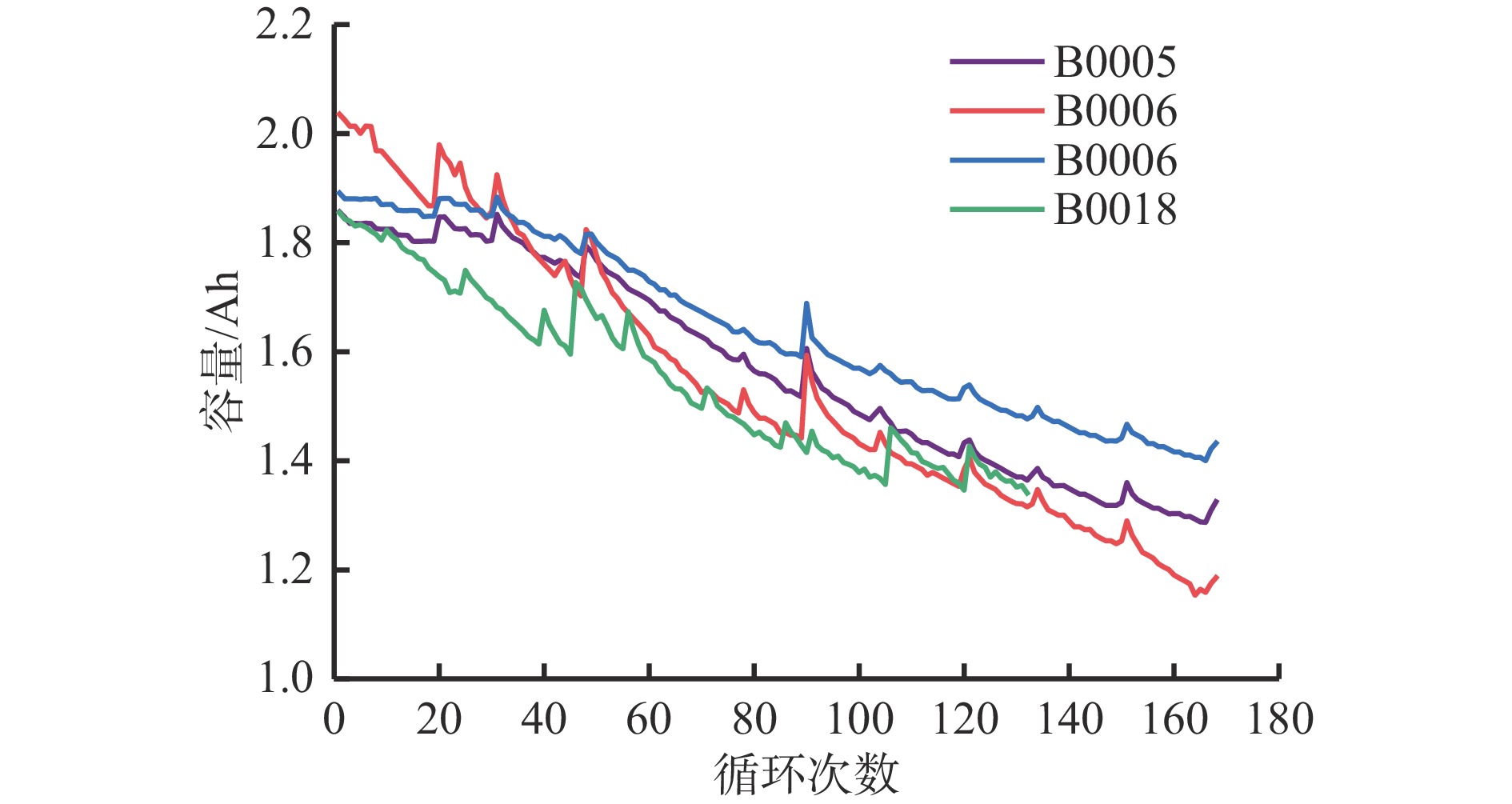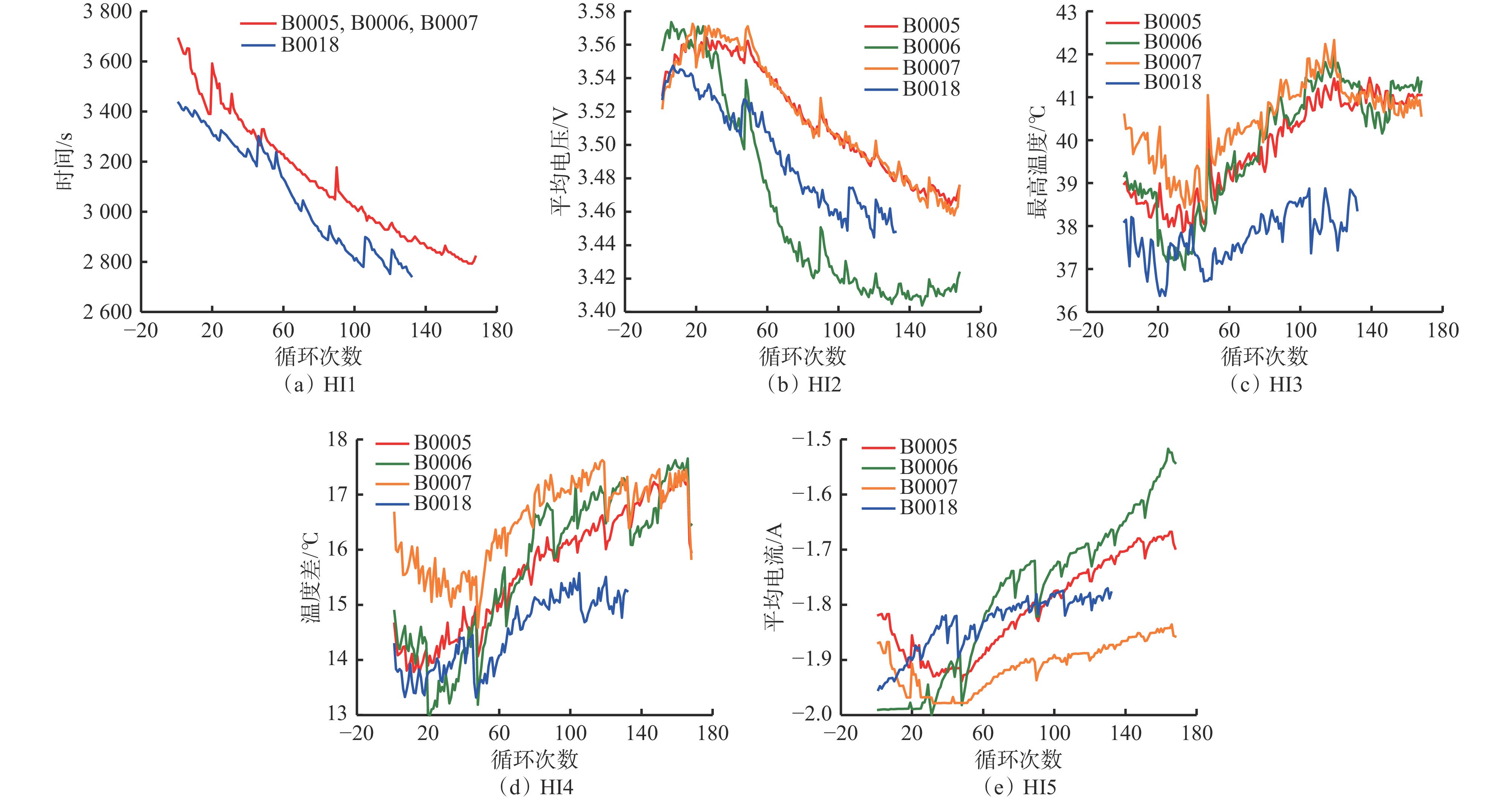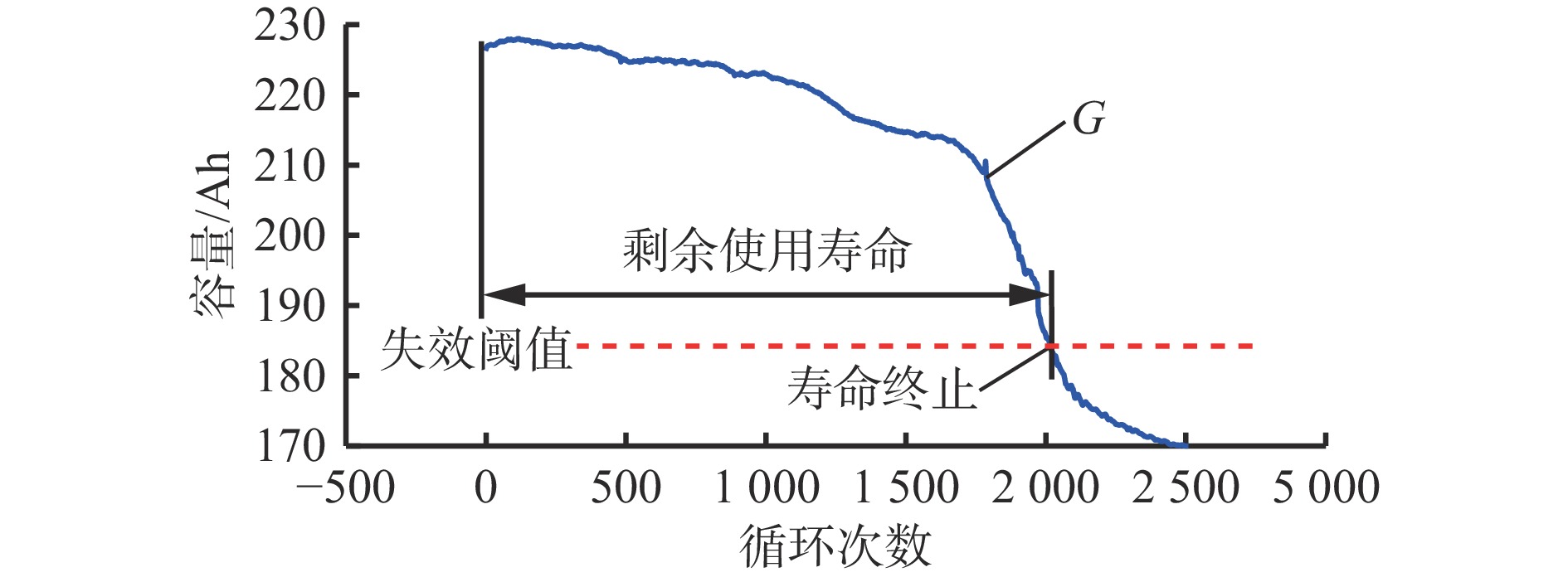State of health prediction of lithium-ion batteries in charging chambers based on multi-modal deep learning
-
摘要:
在井下多尘、潮湿且易爆的环境中,锂电池的退化过程往往呈现非线性、多阶段的特点,传统的单一模型难以全面捕捉其动态变化。针对该问题,提出一种基于多模态深度学习的充电硐室锂电池健康状态预测方法。构建了多模态深度学习网络模型TCN−BiLSTM−Transformer。该模型通过多层级特征提取机制实现时序信号的高效处理:时间卷积网络(TCN)采用具有指数扩展率的空洞卷积核,在保持时序完整性的同时捕获多尺度局部特征;双向长短期记忆网络(BiLSTM)通过双向门控循环单元(GRU)建立时序双向依赖关系,有效识别电池退化过程中的正反向退化特征;Transformer层则通过多头自注意力机制动态分配特征权重,实现全局退化模式的关键特征聚焦。通过锂电池工作过程中的多源传感数据(电压、电流和温度等)作为健康状态表征指标,通过Pearson相关性分析评估健康指标与电池容量的关联性,确定5个间接健康因子并作为预测模型的输入。实验结果表明,该方法的相关度均在98%以上,且均方误差、均方根误差、平均绝对误差、平均绝对百分比误差均较小。在煤矿防爆锂电池模拟工况应用验证中,该方法的相关度达99.47%,与传统方法的预测结果相比,波动幅度更小,精度更高。
Abstract:In underground environments characterized by dust, humidity, and explosion risks, the degradation process of lithium-ion batteries (LIBs) often exhibits nonlinear and multistage characteristics, making it difficult for traditional single models to comprehensively capture their dynamic changes. To address this issue, a multi-modal deep learning-based method was proposed for predicting the state of health of LIBs in charging chambers. A multi-modal deep learning network model, TCN-BiLSTM-Transformer, was constructed, leveraging a multi-level feature extraction mechanism for efficient processing of temporal signals. The Temporal Convolutional Network (TCN), utilizing dilated convolutional kernels with an exponential expansion rate, captured multi-scale local features while preserving temporal integrity. The Bidirectional Long Short-Term Memory Network (BiLSTM) established bidirectional temporal dependencies through bidirectional Gated Recurrent Units (GRUs), effectively identifying both forward and reverse degradation features during battery deterioration. The Transformer layer dynamically allocated feature weights through a multi-head self-attention mechanism, focusing on key features of global degradation patterns. Multi-source sensory data, including voltage, current, and temperature, collected during the battery's operation, were employed as indicators of its health state. Pearson correlation analysis was conducted to evaluate the association between these health indicators and battery capacity, identifying five indirect health factors that served as inputs to the prediction model. Experimental results demonstrated that the proposed method achieved correlations exceeding 98%, with relatively low Mean Squared Error (MSE), Root Mean Squared Error (RMSE), Mean Absolute Error (MAE), and Mean Absolute Percentage Error (MAPE). In validation tests conducted under simulated operating conditions for explosion-proof LIBs in coal mines, the method attained a correlation of 99.47%, exhibiting smaller fluctuations and higher accuracy compared to predictions made using traditional methods.
-
-
表 1 健康因子与电池容量相关系数
Table 1 Correlation coefficient between health factors and battery capacity
数据集 r 指标① 指标② 指标③ 指标④ 指标⑤ 指标⑥ 指标⑦ 指标⑧ 指标⑨ 指标⑩ B0005 0.9755 − 0.9353 0.0364 − 0.9791 − 0.8097 −0.222 − 0.4871 0.4868 0.9824 − 0.9333 B0006 0.9931 − 0.8504 0.1208 −0.92 − 0.8229 0.0532 − 0.4897 0.4986 0.9652 − 0.9891 B0007 0.9820 − 0.7595 − 0.0020 − 0.8652 − 0.5880 0.0299 − 0.3147 0.3194 0.9611 − 0.8092 B0018 0.9926 − 0.6952 0.4230 − 0.9312 − 0.2001 0.6059 0.1176 − 0.0945 0.9856 − 0.9660 表 2 评价指标比较
Table 2 Comparison of evaluation indicators
实验 参数 eMSE/10−4 eRMSE/10−2 eMAE/10−2 eMAPE/% R²/% 1 N=1 8.2 3.3 2.6 1.72 96.97 N=2 2.3 3.4 2.8 1.85 96.72 N=3 4.9 5.4 4.5 2.84 91.78 N=4 9.6 1.5 1.1 0.80 98.70 2 d=1 10.7 2.8 2.3 1.58 97.69 d=2 11.7 1.5 1.1 0.80 98.70 d=3 29.2 2.2 1.7 1.18 98.60 d=4 2.30 3.1 2.3 1.46 97.28 3 Nm=1 12.1 3.4 2.9 1.93 96.62 Nm=2 8.6 2.9 2.4 1.56 97.58 Nm=3 17.9 4.2 3.2 2.06 94.97 Nm=4 2.3 1.5 1.1 0.80 98.70 表 3 不同方法的预测结果
Table 3 Prediction results of different methods
数据集 方法 eMSE/10−4 eRMSE/10−2 eMAE/10−2 eMAPE/% R²/% B0005 法① 2.3 1.5 1.12 0.80 98.70 法② 5.0 1.9 1.72 1.05 95.43 法③ 4.9 2.2 1.7 1.20 94.20 法④ 14.9 3.8 3.2 2.18 91.57 B0006 法① 8.9 2.9 2.2 1.76 98.45 法② 9.3 3.06 2.4 1.69 95.24 法③ 9.7 3.1 2.3 1.77 95.03 法④ 33.6 5.7 5.1 3.69 82.94 B0007 法① 1.6 1.2 1.1 0.69 98.47 法② 2.5 1.5 1.3 0.87 97.70 法③ 4.9 2.2 1.9 1.22 95.47 法④ 27.6 5.2 4.5 2.91 74.62 B0018 法① 2.8 1.6 1.2 0.85 98.32 法② 3.0 1.7 1.3 0.90 96.18 法③ 6.9 2.6 2.0 1.38 93.51 法④ 11.6 3.4 2.5 1.71 89.23 表 4 模型指标比较
Table 4 Comparison of model indicators
数据集 方法 eMSE/10−4 eRMSE/10−2 eMAE/10−2 eMAPE/% R²/% B0005 法Ⅰ 11.4 3.4 9.51 1.76 92.41 法Ⅱ 7.5 2.6 9.42 1.43 93.73 法Ⅲ 12.1 1.8 3.60 1.62 92.84 法① 2.3 1.5 1.12 0.80 98.70 B0006 法Ⅰ 10.1 2.8 8.38 1.31 93.52 法Ⅱ 13.2 3.5 6.35 1.24 94.12 法Ⅲ 15.7 7.1 5.24 1.38 91.74 法① 8.9 2.9 2.2 1.76 98.45 B0007 法Ⅰ 9.2 1.6 2.05 1.01 94.45 法Ⅱ 9.7 2.3 3.24 1.53 93.62 法Ⅲ 17.6 4.7 4.81 2.54 89.43 法① 1.6 1.2 1.1 0.69 98.47 B0018 法Ⅰ 13.5 3.7 2.85 1.95 89.74 法Ⅱ 10.7 3.1 4.72 2.17 90.17 法Ⅲ 12.8 2.2 3.46 1.82 90.91 法① 2.8 1.6 1.2 0.85 98.32 表 5 实验指标比较
Table 5 Comparison of experimental indicators
方法 eMSE eRMSE eMAE eMAPE/% R²/% 法① 2.0389 1.4279 1.1671 0.5667 99.47 法② 11.2094 10.5732 2.3569 1.1752 93.47 法③ 10.1531 3.2458 2.3872 1.2619 94.18 法④ 30.9356 6.3243 4.4823 2.2043 91.25 -
[1] 姜玉叶. 矿用锂离子电池状态监测与寿命预测研究[D]. 徐州:中国矿业大学,2015. JIANG Yuye. Condition monitoring and life prediction study of mine lithium-ion battery[D]. Xuzhou:China University of Mining and Technology,2015.
[2] 张云飞. 基于IBA—SVR的电池快换车电池健康状态研究[J]. 工矿自动化,2024,50(增刊2):148-152. ZHANG Yunfei. Study on the health status of batteries based on IBA-SVR[J]. Journal of Mine Automation,2024,50(S2):148-152.
[3] 朴博晖,彭俊荣,杨一鹏,等. 基于改进Transformer的锂电池剩余寿命预测[J]. 船电技术,2024,44(2):77-80. PIAO Bohui,PENG Junrong,YANG Yipeng,et al. Prediction of remaining life of lithium batteries based on improved transformer[J]. Marine Electric & Electronic Engineering,2024,44(2):77-80.
[4] 李起伟,陈伟,张健,等. 矿用防爆锂电源均流系统设计[J]. 工矿自动化,2021,47(12):13-18. LI Qiwei,CHEN Wei,ZHANG Jian,et al. Design of current sharing system for mine explosion-proof lithium power supply[J]. Industry and Mine Automation,2021,47(12):13-18.
[5] 李新海,李强,张鹏,等. 井下智能化蓄电池充电技术的研究与应用[J]. 煤矿机械,2017,38(12):118-119. LI Xinhai,LI Qiang,ZHANG Peng,et al. Research and application of changing technology for intelligent storage battery in under ground mine[J]. Coal Mine Machinery,2017,38(12):118-119.
[6] 夏西进,尹承山,张鹏. 防爆蓄电池机车智能充电硐室实践应用[J]. 中国高新技术企业,2015(27):59-60. XIA Xijin,YIN Chengshan,ZHANG Peng. Practice and application of intelligent charging chamber for explosion-proof battery locomotive[J]. China High-Tech Enterprises,2015(27):59-60.
[7] 梁佳佳,何晓霞,肖浩逸. 基于CS−DBN的锂电池剩余寿命预测[J]. 太阳能学报,2024,45(3):251-259. LIANG Jiajia,HE Xiaoxia,XIAO Haoyi. Prediction of remaining useful life of lithium batteries based on CS-DBN[J]. Acta Energiae Solaris Sinica,2024,45(3):251-259.
[8] 胡而已,吕东翰,王春涛,等. 煤矿机器人智能安全充电系统设计[J]. 煤炭科学技术,2020,48(2):171-175. HU Eryi,LYU Donghan,WANG Chuntao,et al. Design of intelligent safety charging system for coal mining robot[J]. Coal Science and Technology,2020,48(2):171-175.
[9] 刘斌,吉春霖,曹丽君,等. 基于自适应噪声完全集合经验模态分解与BiLSTM−Transformer的锂离子电池剩余使用寿命预测[J]. 电力系统保护与控制,2024,52(15):167-177. LIU Bin,JI Chunlin,CAO Lijun,et al. Prediction of remaining service life of lithium-ion batteries based on complete ensemble empirical mode decomposition with adaptive noise and BiLSTM-Transformer[J]. Power System Protection and Control,2024,52(15):167-177.
[10] 林晶,张学明,董静,等. 基于健康因子和Attention−GRU的锂电池剩余使用寿命预测 [J/OL]. 南京信息工程大学学报:1-14[2024-12-05]. https://doi.org/10.13878/j.cnki.jnuist.20240801002. LIN Jing,ZHANG Xueming,DONG Jing,et al. Prediction of remaining useful life of lithium battery based on health factors and Attention-GRU[J/OL]. Journal of Nanjing University of Information Science & Technology:1-14[2024-12-05]. https://doi.org/10.13878/j.cnki.jnuist.20240801002.
[11] 郭喜峰,黄裕海,单丹,等. 改进NGO优化MVMD−BiLSTM的锂电池剩余使用寿命预测[J/OL]. 电源学报:1-12[2024-12-05]. http://kns.cnki. net/kcms/detail/12.1420.TM.20240426.1221.063.html. GUO Xifeng,HUANG Yuhai,SHAN Dan,et al. Improved NGO optimized MVMD-BiLSTM for remaining useful life prediction oflithium battery[J/OL]. Journal of Power Supply:1-12[2024-12-05]. http://kns.cnki. net/kcms/detail/12.1420.TM.20240426.1221.063.html.
[12] 廖列法,占玉敏,刘映宝. 基于IViT的锂离子电池健康状态估计[J]. 电子测量技术,2024,47(18):63-70. LIAO Liefa,ZHAN Yumin,LIU Yingbao. Lithium-ion battery state of health estimation based on IViT[J]. Electronic Measurement Technology,2024,47(18):63-70.
[13] NI Yiwei,DING Xuqiang,WANG Qi. Improved sparrow algorithm to optimize kernel extreme learning machines for lithium battery status of health estimation on incremental capacity curve[J]. Journal of Physics:Conference Series,2024,2876(1). DOI:10.1088/ 1742-6596/2876/1/012027.
[14] 史云,汪立伟,公岷. 基于卷积注意力机制的锂离子电池剩余使用寿命预测研究[J]. 西南民族大学学报(自然科学版),2024,50(3):336-346. DOI: 10.11920/xnmdzk.2024.03.013 SHI Yun,WANG Liwei,GONG Min. Research on prediction of remaining useful life of lithium-ion batteries based on convolutional attention mechanism[J]. Journal of Southwest Minzu University (Natural Science Edition),2024,50(3):336-346. DOI: 10.11920/xnmdzk.2024.03.013
[15] 师芸,折夏雨,张雨欣,等. SBAS−InSAR技术融合CNN−LSTM模型的矿区开采沉陷监测与预测[J]. 安全与环境学报,2024,24(9):3429-3438. SHI Yun,SHE Xiayu,ZHANG Yuxin,et al. Monitoring and predicting mining subsidence in mining areas through SBAS-InSAR and CNN-LSTM[J]. Journal of Safety and Environment,2024,24(9):3429-3438.
[16] 吴诗淼. 基于跳跃连接多尺度CNN−BiLSTM的锂电池剩余寿命预测[D]. 武汉:武汉科技大学,2024. WU Shimiao. Residual life prediction of lithium-ion batteries based on skip-connected multi-scale CNN-BiLSTM[D]. Wuhan:Wuhan University of Science and Technology,2024.
[17] 孟春,汪济洲,彭相,等. 基于GAN−BiLSTM的锂电池RUL预测[J]. 黑龙江工业学院学报(综合版),2023,23(3):51-56. MENG Chun,WANG Jizhou,PENG Xiang,et al. RUL prediction of lithium batteries based on GAN-BiLSTM[J]. Journal of Heilongjiang University of Technology (Comprehensive Edition),2023,23(3):51-56.
[18] 盛瑞祥,张啸宇. 基于概率TCN−Transformer的短期光伏功率预测模型[J]. 综合智慧能源,2024,46(11):10-18. SHENG Ruixiang,ZHANG Xiaoyu. Photovoltaic power forecasting model based on probabilistic TCN-Transformer[J]. Integrated Intelligent Energy,2024,46(11):10-18.
[19] ZHANG Kai,YIN Jianxiang,HE Yunze. Acoustic emission detection and analysis method for health status of lithium ion batteries[J]. Sensors,2021,21(3). DOI: 10.3390/S21030712.
[20] 刘恩海,付英健,张智,等. 联合Transformer注意力机制的PM2.5浓度预测网络研究[J]. 安全与环境学报,2023,23(10):3760-3768. LIU Enhai,FU Yingjian,ZHANG Zhi,et al. PM2.5 recurrent prediction network combined with transformer attention mechanism[J]. Journal of Safety and Environment,2023,23(10):3760-3768.
[21] 门庆玉,张柯柯,杨静,等. 基于改进指数模型的锂电池容量估计和RUL预测[J]. 电工技术,2024(16):50-53. MEN Qingyu,ZHANG Keke,YANG Jing,et al. Modified exponential model-based capacity estimation and RUL prediction for lithium-ion batteries[J]. Electric Engineering,2024(16):50-53.
-
期刊类型引用(44)
1. 马宏伟,薛旭升,毛清华,齐爱玲,王鹏,聂珍,张旭辉,曹现刚,赵英杰,郭逸风. 论“采煤就是采数据”的学术思想. 煤炭科学技术. 2025(01): 272-283 .  百度学术
百度学术
2. 朱懋. 采煤机重载工况下转矩自动化补偿控制方法的研究. 机械管理开发. 2024(06): 323-325 .  百度学术
百度学术
3. 张超. 基于模块化总线技术的采煤机自动监控系统设计. 矿业装备. 2024(12): 178-180 .  百度学术
百度学术
4. 管政. 模糊PID电液控制对采煤机姿态调整的效果分析. 机械管理开发. 2023(08): 29-30+33 .  百度学术
百度学术
5. 陈浩锐. 基于PLC的掘进机截割控制系统研究. 机械管理开发. 2023(08): 200-201+204 .  百度学术
百度学术
6. 李春华,孙晓,宁权. 智能化采煤工作面采煤机自动监控系统的设计与应用. 山东煤炭科技. 2023(10): 87-90 .  百度学术
百度学术
7. 李乾. 电驱动采煤机控制系统设计与实现. 机械研究与应用. 2023(05): 164-167 .  百度学术
百度学术
8. 张宇杰. 采煤机与刮板输送机联动运行控制技术的应用研究. 机械管理开发. 2023(11): 284-286 .  百度学术
百度学术
9. 赵晓璐. 采煤机运行状态监控系统设计及应用分析. 西部探矿工程. 2023(12): 162-164 .  百度学术
百度学术
10. 刘晓鹏. 基于PLC的采煤机智能控制系统设计. 机械管理开发. 2022(02): 230-232 .  百度学术
百度学术
11. 常映辉. 采煤机自动化自整定控制系统的设计及效果分析. 现代工业经济和信息化. 2022(08): 29-30+56 .  百度学术
百度学术
12. 叶竹刚. 适用于自动化工作面的采煤机控制系统研究. 机械管理开发. 2022(12): 258-259+262 .  百度学术
百度学术
13. 魏勇. 电牵引采煤机电控系统的优化设计与改造. 机电工程技术. 2021(01): 197-199 .  百度学术
百度学术
14. 李春庆. 突变工况下采煤机机电控制优化. 机械管理开发. 2021(01): 101-103 .  百度学术
百度学术
15. 韵凯. 采煤机记忆截割控制系统的研究与设计. 机械管理开发. 2021(06): 245-247 .  百度学术
百度学术
16. 许连丙. 基于多传感器信息融合的采煤机状态监测系统设计. 自动化应用. 2021(04): 126-127+130 .  百度学术
百度学术
17. 贺新星. 基于智能自动化的采煤机协同控制系统设计. 中国新技术新产品. 2021(11): 5-8 .  百度学术
百度学术
18. 王振东. 采煤机智能控制系统的优化研究. 机械管理开发. 2021(08): 271-272 .  百度学术
百度学术
19. 蔡德程,陈缤,关欣,李郝林. 机床热特性优化研究综述. 上海理工大学学报. 2021(05): 443-451 .  百度学术
百度学术
20. 李强. 基于PLC的采煤机运行监控系统设计. 机电工程技术. 2020(01): 36-37 .  百度学术
百度学术
21. 张旭辉,潘格格,张雨萌,樊红卫,毛清华,车万里,薛旭升,王川伟,赵友军. 采掘装备绿色设计与评价技术研究. 工矿自动化. 2020(02): 23-28+49 .  本站查看
本站查看
22. 郭帅. 机械化采煤中电气自动化的应用. 当代化工研究. 2020(04): 70-71 .  百度学术
百度学术
23. 闫珂. 提高变频器驱动型提升机运行稳定性的策略研究. 机械管理开发. 2020(03): 58-60 .  百度学术
百度学术
24. 杨健,李小辉. 掘进工作面远程视频监控控制系统设计. 中国石油和化工标准与质量. 2020(04): 220-221 .  百度学术
百度学术
25. 王玮. 矿井综采工作面智能综采控制系统研究. 机电工程技术. 2020(04): 122-123+186 .  百度学术
百度学术
26. 淮文军,王明芳. 基于DSP和PLC的电牵引采煤机电控系统优化设计. 煤矿机械. 2020(05): 206-208 .  百度学术
百度学术
27. 兰天安. 煤矿采煤机控制系统设计研究. 能源与环保. 2020(05): 113-115+126 .  百度学术
百度学术
28. 刘章敏. 煤矿综采工作面智能监控系统设计. 机电工程技术. 2020(05): 106-107+126 .  百度学术
百度学术
29. 周展,赵亦辉,刘庚,蒋峰. 基于ACS800变频控制技术的采煤机变频调速系统. 煤矿机电. 2020(03): 16-19 .  百度学术
百度学术
30. 付欣睿. 煤矿电牵引采煤机自动控制系统设计. 机械管理开发. 2020(10): 249-250+265 .  百度学术
百度学术
31. 张耀明. 自动化工作面电牵引采煤机控制系统优化设. 煤炭科技. 2020(05): 36-38 .  百度学术
百度学术
32. 王振宇. 采煤机信息系统的设计与实现. 机械管理开发. 2020(11): 223-224+254 .  百度学术
百度学术
33. 曹连民,孙士娇,李建楠,吕玉廷. 煤矿工作面采煤机虚拟仿真实验教学研究. 实验技术与管理. 2019(02): 198-203 .  百度学术
百度学术
34. 樊大鹏. 以多传感器为基础的电牵引采煤机监测监控系统探析. 机电工程技术. 2019(01): 158-160 .  百度学术
百度学术
35. 杨成喜. 电牵引采煤机调高系统的操作及维护探讨. 机电工程技术. 2019(01): 155-157 .  百度学术
百度学术
36. 刘春亮. 交流变频调速采煤机恒功率自动控制系统研究. 机电工程技术. 2019(04): 49-50+139 .  百度学术
百度学术
37. 韩冰. 基于PLC的采煤机远程监控系统设计. 化学工程与装备. 2019(11): 173-174 .  百度学术
百度学术
38. 张旭辉,谢亚洲. 基于DSP的悬臂式掘进机控制系统设计. 煤炭工程. 2019(12): 172-176 .  百度学术
百度学术
39. 薛瑞梓. 煤矿采煤机自动化控制系统的研究和设计. 机电工程技术. 2019(12): 67-69 .  百度学术
百度学术
40. 刘福平. 电牵引采煤机电控系统的研究与改进. 机械管理开发. 2018(06): 204-205+230 .  百度学术
百度学术
41. 许刚. 多传感器下的电牵引采煤机综合监测系统分析. 煤矿机械. 2018(02): 55-57 .  百度学术
百度学术
42. 赵友军,赵亦辉,张旭辉. 采煤机数字化技术发展及展望. 重型机械. 2018(04): 29-34 .  百度学术
百度学术
43. 安全林. 大采高工作面采煤自动化在阳煤一矿的应用与探讨. 能源技术与管理. 2017(03): 174-175 .  百度学术
百度学术
44. 李玉华,杨传常,闫业臣,刘广民. 采煤机电缆牵引拉力过载保护装置. 工矿自动化. 2017(12): 11-15 .  本站查看
本站查看
其他类型引用(10)




 下载:
下载:








